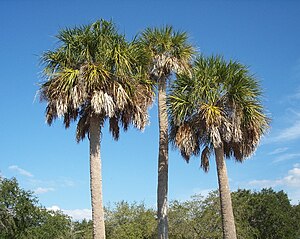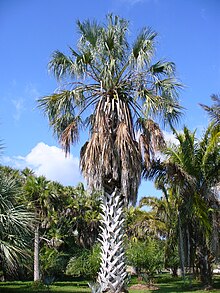Sabal
| Sabal | ||||||||||||
|---|---|---|---|---|---|---|---|---|---|---|---|---|

|
||||||||||||
| Systematics | ||||||||||||
|
||||||||||||
| Scientific name | ||||||||||||
| Sabal | ||||||||||||
| Adans. |
Sabal is a palm genus native to America, in which single- stemmed fan palms of different sizesare summarized. Some species are used as ornamental plants . The genus alone forms the tribe Sabaleae .
features
The representatives are single- stemmed fan palms . They are dwarf to large, stemless or erect and unarmed. The plants are several times flowering and hermaphroditic. The trunk is often prostrate and bent downwards. It is covered with leaf bases, rough and indistinctly curled, but can also become smooth with increasing age.
The chromosome number is 2n = 36.
leaves
The leaves are short or distinctly costapalmat. They are folded induplicately and remain on the plant after they have died (Marzeszenz). The leaf sheath has a noticeable crevice under the petiole, the edges of the leaf sheath are fibrous. The petiole is often very long. The adaxial hastula is short and blunt, or more often long and pointed with a sharp edge, the abaxial hastula is sometimes recognizable as a flat back.
The leaf blade is flat or more often curved. Along the central abaxial fold it is divided to the middle or almost to the rib, further divisions are along the adaxial folds. The result is linear, almost identical, simply folded leaf segments that are short to deep in two parts. The midrib of the segments is conspicuous abaxially.
Inflorescences
The inflorescences are between the leaves (interfoliar) and form side axes of the fourth order. The cover sheet is short, two-keeled and bilobed. The multiple bracts on the peduncle are tubular below with a conspicuous and narrow tip. The inflorescence axis is as long as or longer than the inflorescence stalk. The bracts of the inflorescence axis resemble those on the stem, but get smaller towards the tip.
The bracts on the axes of the second and third order are clearly pronounced, tubular and become smaller towards the axis tip. There is a cover sheet on most axes. The flower-bearing axes (rachillae) are slender, their bracts are arranged in a spiral, each has a small side branch with a single flower.
blossoms
The flowers of this genus are hermaphroditic. They are symmetrical. The calyx is somewhat thickened at the base, tubular and weakly three-lobed. When dry, the nerves are often prominent. The crown is tubular in the lower part, the lobes are elliptical and slightly imbricat in the bud . The six stamens have rather fleshy, flat stamens that are fused together to form a tube in the lower part. Your free area is awl-shaped and not curved inwards at the tip. The anthers are dorsifix, narrowly elliptical, and latrors. The three carpels are fully grown, the ovary is three-lobed and only slightly wider than the long dreigefurchte pen . The scar is head-shaped, three-lobed and papillary. The ovules are basal and anatropic.
The pollen is ellipsoidal and slightly asymmetrical. The germ opening is a distal sulcus. The longest axis measures 33 to 50 microns.
Fruits and seeds
The fruit usually develops from only one carpel, sometimes from two or all three. It is spherical to pear-shaped. At the base are the scar remnants and abortive carpels. The exocarp is smooth, the mesocarp fleshy without fibers, the endocarp is thin and membranous.
The semen is not fused with the endocarp, is shiny brown and spherical. The raphe and scar are basal. The endosperm is homogeneous.
Distribution and locations
The range of the genus is limited to the western hemisphere. The area stretches from Colombia in the south to the northeast of Mexico and the southeast of the USA and includes the entire Caribbean basin.
Some species, particularly the dwarf palmetto palm ( Sabal minor ), grow in swampy areas, others in sandy coastal areas or in open, dry locations.
Systematics
The genus Sabal Adans. is placed within the family Arecaceae in the subfamily Coryphoideae and alone forms the tribe Sabaleae. Her sister group is the Cryosophileae tribe .
The Royal Botanic Gardens, Kew's World Checklist of Selected Plant Families recognizes the following species:
- Sabal antillensis M.P. handle. : The home of the species first described in 2017 is Curaçao and Bonaire .
- Sabal bermudana L.H.Bailey : The home is Bermuda .
- Sabal × brazoriensis D.H. Goldman, Lockett & Read : This natural hybrid occurs only in Brazoria County in the US state of Texas .
- Sabal causiarum (OFCook) Becc. : The homeland ranges from Hispaniola to the Virgin Islands .
- Sabal domingensis Becc. : The homeland ranges from Cuba to Hispaniola.
- Sabal etonia Swingle ex Nash (Syn .: Sabal miamiensis Zona ): The home is Florida.
- Sabal gretherae H.J.Quero : The home is Mexico.
- Sabal maritima (Kunth) Burret : The home is Cuba and Jamaica.
- Sabal mauritiiformis (H.Karst.) Griseb. & H. Wendl. : The distribution area extends from Mexico to Venezuela and Trinidad.
- Sabal mexicana Mart. : The distribution area extends from southern Texas to Central America.
- Dwarf palmetto palm ( Sabal minor (Jacq.) Pers. ): The range extends from Oklahoma and the southeastern USA to Mexico.
- Palmetto palm ( Sabal palmetto (Walter) Lodd. Ex Schult. & Schult.f. ): The range extends from the southeastern United States to Cuba.
- Sabal pumos (Kunth) Burret : The home is Mexico.
- Sabal rosei (OFCook) Becc. : The home is Mexico.
- Sabal uresana Trel. : The home is Mexico.
- Sabal yapa C. Wright ex Becc. : The home is Mexico, Belize and western Cuba.
use
In the past, palm trees were used to make brooms and to cover roofs. Today a number of species are used as ornamental plants.
supporting documents
- John Dransfield, Natalie W. Uhl, Conny B. Asmussen, William J. Baker, Madeline M. Harley, Carl E. Lewis: Genera Palmarum. The Evolution and Classification of Palms . Second edition, Royal Botanic Gardens, Kew 2008, ISBN 978-1-84246-182-2 , pp. 216-218.
Individual evidence
- ↑ a b Rafaël Govaerts (Ed.): Sabal. In: World Checklist of Selected Plant Families (WCSP) - The Board of Trustees of the Royal Botanic Gardens, Kew . Retrieved August 2, 2018.
Web links
- Sabal on the homepage of the Fairchild Tropical Botanic Garden



